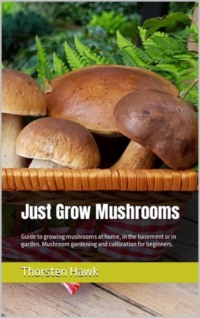Loe raamatut: «Just Grow Mushrooms»
Just Grow Mushrooms
Guide to growing mushrooms at home, in the basement or in garden. Mushroom gardening and cultivation for beginners.
By Thorsten Hawk
contents
Advice on growing mushrooms yourself in the basement, apartment or garden
1. What are mushrooms?
2. Life cycle and way of life
3. Which mushrooms can you grow yourself?
4. Nutritional Values and Medicinal Effects of Mushrooms
5. Nutritional values and medicinal properties of oyster mushrooms
6. Nutritional Values and Medicinal Effects of Shiitake
7. The importance of cleanliness
8. How to practice cleanliness?
9. Optimal growing conditions
10. What is needed?
11. Which substrates are suitable?
12. 6 steps to growing mushrooms
13. 1. Pure culture production
14. Make 2nd Mushroom Spawn
15. 3. Inoculate
16. 4th growing through phase
17. 5. Fruiting body formation
18th 6th Harvest
19. Mushroom growing garden on wood chips or straw bales
20. Mushroom growing in the basement on sawdust, coffee grounds, straw pellets
21. Growing mushrooms in the apartment on sawdust, coffee grounds
22. Storing and preserving mushrooms
23. Tips for care
24. Tips against pests
25. Use mushrooms from the supermarket for breeding?
Conclusion: grow mushrooms yourself
Advice on growing mushrooms yourself in the basement, apartment or garden
Fungi are the oldest and most diverse organisms on our planet. Unlike plants, they do not use photosynthesis and prefer moist, shady locations. Mushrooms contain many nutrients and are particularly low in calories. In Chinese medicine, mushrooms are known for their healing properties. Various symptoms can be alleviated by consumption.
So it is not at all surprising that they are so popular. Many hobby growers create their own mushroom cultures in their gardens or cellars. You really can't get mushrooms fresher than from your own culture. In this guide you will find out everything you need to know about growing these delicious mushrooms at home. Hygiene in mushroom cultivation in particular is one of the most important core criteria.

1. What are mushrooms?
Fungi form their own kingdom, they are called eukaryotes. Unlike plants, fungi do not photosynthesize, they feed heterotrophically. They are among the microorganisms, because fungi are unicellular or multicellular. Fungi are particularly diverse, both morphologically and physiologically. The fungus spreads via spores.
Fungi can form hyphae, mycelia and fruiting bodies. The different fungi are classified into microscopic fungi, ascomycetes and basidiomycetes. The ascomycetes refer to the so-called sac fungi, the basidiomycetes include the pillar fungi. However, the systematics of the different fungi is much more complex due to their biodiversity.
Fungi are of considerable importance for the material cycle because they break down organic matter. The impressive organisms are of great importance for life on earth, life without them would not be possible.
Mushrooms are indisputably one of the oldest and most diverse creatures in the world. The area of application of the mushrooms is large, they can be found in food production, industry and the production of active ingredients. Edible mushrooms are extremely popular and an indispensable part of various dishes.
2. Life cycle and way of life
When people think of mushrooms, they envision the fruiting bodies that grow above ground, but that is the smaller part of the fungus. The root is the much larger part of the fungal organism, they are underground. The larger part of the fungus is called the mycelium, which can spread underground for miles.
The mushroom consists of several parts. The mushroom fruiting body consists of a stalk, cap, lamellae, tubes or pores. Champions belong to the lamellar mushrooms, while porcini mushrooms belong to the tubular mushrooms. Reishi is one of the porous mushrooms. The mushrooms are classified based on this property. The seeds of the fungi are the spores, which are found in the lamellae, tubes or pores. When the spores are fully mature, they fall out.
So that the fungal spores can germinate and a fungus can develop from them, they must find a suitable breeding ground. Germination requires optimal growth conditions. The humidity as well as the temperature play an important role.
It is interesting to know that there are positively and negatively polarized representatives of the spores. Independently of each other, these begin to germinate under optimal conditions.
A new mushroom mycelium is created when two spore germs attach to each other. Small mini mushrooms emerge and develop into the finished fruiting bodies. These in turn form spores and another life cycle begins. Local mushroom cultivation follows this natural principle.
The breeding cycle follows the same technique or way of life as that of the natural models. The difference is that the substrates used and the climatic conditions are different than in nature. The spores are examined under the microscope in the laboratory. The spores are on a suitable culture medium in Petri dishes, in which they germinate.
The strongest mycelium strands are suitable for grafting through selection, which increases the yield. The mycelium is now placed on a grain-based substrate. This substrate is called grain spawn.
If the grain spawn is completely colonized with mushroom mycelium, it is suitable for inoculating a fruiting substrate. The fungus then grows through this fruit substrate.
Tasuta katkend on lõppenud.
